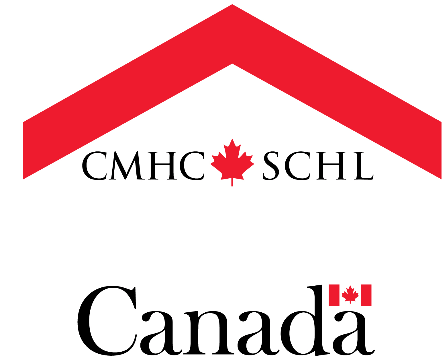
By Leith van Onselen
In the years following the global financial crisis (GFC), the Canadian and Australian housing markets were among the best performing in the English-speaking world. While housing markets in other English-speaking nations- most notably the United States, Ireland, the United Kingdom, and New Zealand – remained in a funk, Canada’s and Australia’s powered on to new all-time highs.
Whereas Australia’s house prices peaked in mid-2010, and have been deflating ever since, Canada’s powered on led by its third largest metropolis, Vancouver, British Columbia:
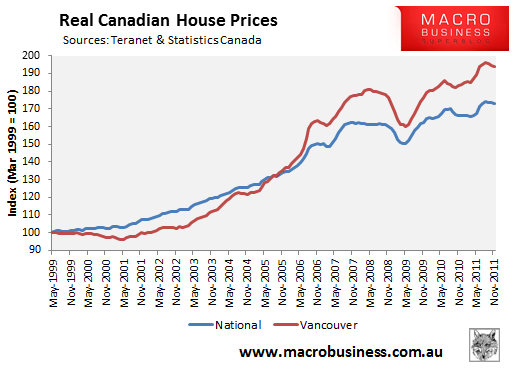
By mid-2011, the Canadian authorities were growing nervous, culminating in a captivating speech by Canada’s central bank governor, Mark Carney, in which he pointed out some home truths about the bubble-like situation that had developed in Canada’s housing market.
In his speech, Mr Carney showed that the growth in house prices had easily outpaced Canadian inflation and incomes, and questioned whether this growth in housing values had made Canada better off:
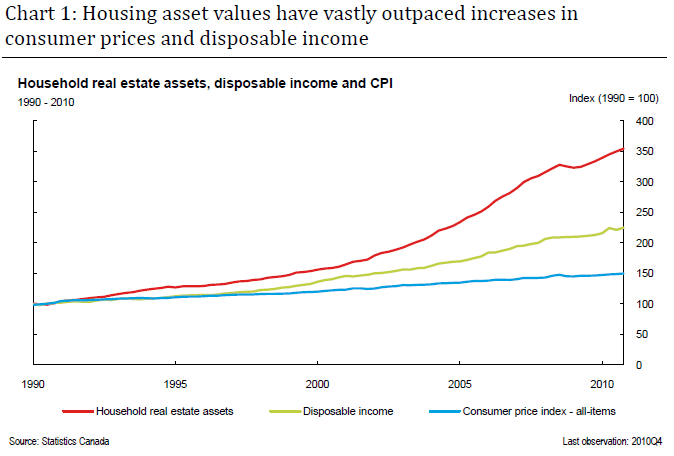
Canada is arguably no better off because of it [higher house prices]. That’s because while homeowners may feel wealthier because of this rise in prices, housing is not net national wealth. Some Canadians are long housing; others are short. Housing developments can have important implications for equality both across and between generations. Though some people in this room may have been enriched, their children and neighbours may have been relatively impoverished.
Mr Carney also showed that Canadian house prices relative to rents were near all-time highs:
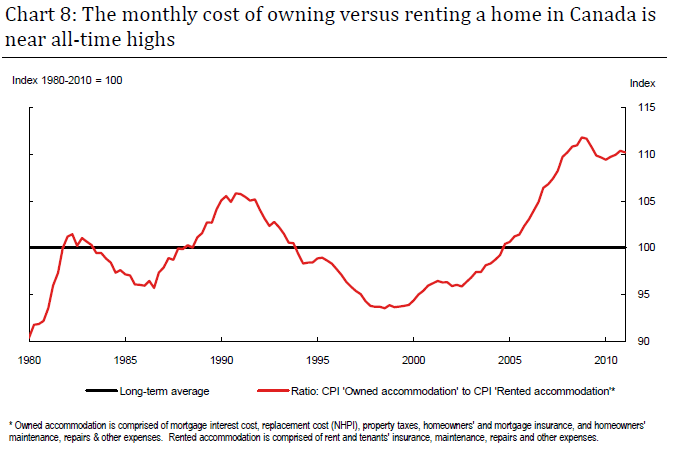
Which is a view supported by the International Monetary Fund (IMF), which shows Canada’s ratio of house prices-to-rents to be the highest in the developed world:
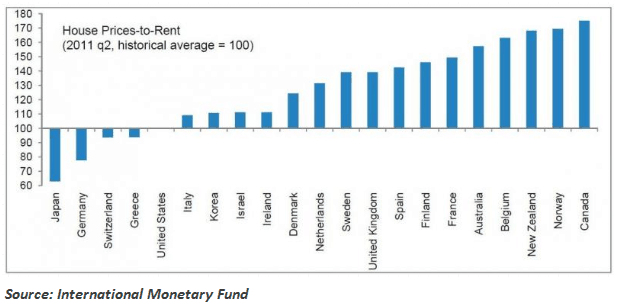
Carney also warned about the high levels of household debt in Canada, which had been rising inexorably and had for the first time risen above 150% of personal disposable incomes:
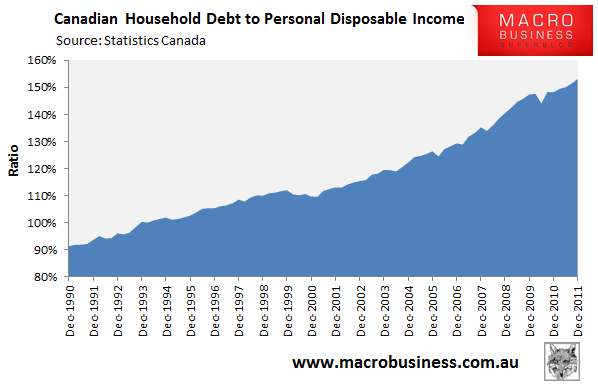
Financial vulnerabilities have increased as a result. Canadians are now as indebted (relative to their income) as the Americans and the British. The Bank estimates that the proportion of Canadian households that would be highly vulnerable to an adverse economic shock has risen to its highest level in nine years, despite improving economic conditions and the ongoing low level of interest rates.
Carney warned that some segments of Canada’s housing market (Vancouver in particular) were experiencing bubble-like behaviour:
Given such developments, one cannot totally discount the possibility that some pockets of the Canadian housing market are taking on characteristics of financial asset markets, where expectations can dominate underlying forces of supply and demand. The risk is that expectations become extrapolative, prompting the classic market emotions of greed and fear—greed among speculators and investors—and fear among households that getting a foot on the property ladder is a now-or-never proposition.
And suggested that the ‘wealth effect’ positive feedback loop from house price movements could shift into reverse if house prices correct, reducing consumer spending and lowering economic growth:
…while changes in housing values may not lead to changes in net wealth, they do influence consumption by affecting households’ access to credit. Through this “financial-accelerator” effect, homeowners can borrow more against increases in home equity to finance home renovations, the purchase of a second house, or other goods and services. Such expenditures can accelerate the increase in house prices, reinforcing the growth in collateral values and access to borrowing, leading to a further rise in household spending. Of course, this financial accelerator can also work in reverse: a decrease in house prices tends to reduce household borrowing capacity, and amplify the decline in spending.
Since Mr Carney’s speech, the Canadian housing market has finally begun to turn down, falling -0.3% nationally in the two months to November (-0.6% in Vancouver in the three months to November) according to Teranet. And it seems the national mood might be changing too, with a wide range of publications recently warning of a possible bubble and/or projecting falling housing prices, including:
- The esteemed national magazine, Macleans.ca, declaring: “Yes we’re in a bubble and it will probably pop soon.”
- The Economist asking readers: “Are Canadian house prices a bubble waiting to burst?”. Nearly two-thirds of readers responded in the affirmative.
- TD Bank predicting that price growth will slow in 2012, with a correction taking place in 2013.
- Bloomberg reporting that Canadian housing is poised for a “severe correction”.
- Sharply rising foreclosures in the city of Kelowna, British Columbia, which is home to 180,000 Canadians.
Meanwhile, rental growth across Canada has reportedly flatlined, and there is a flood of new apartments being built in the nation’s largest metropolis, the Greater Toronto Area.
On the other hand, many commentators and analysts still do not believe that Canada’s housing market will suffer a severe correction, citing Canada’s ‘conservative’ lending practices and its ‘world’s best’ banking system, which was ranked safest in the world by the 2011-12 World Economic Forum Global Competitiveness Report.
Peak under the hood, however, and you find: (i) that the Canadian banks have arguably received their world-beating ‘safe’ status because most of the credit risk on their loans is being carried by Canadian taxpayers who, via the Canadian Mortgage Housing Corporation (CMHC), are the guarantors of a significant portion of Canada’s riskiest mortgages and are on the hook to lose billions should the Canadian housing market ever falter; and (ii) a system entwined in moral hazards and questionable lending practices.
CMHC: the Great Enabler:
The government-owned CMHC is Canada’s national housing agency. CMHC works by acting as the guarantor for mortgages where the purchaser is unable to pay a specified amount as a down payment (20% for residential properties). The CMHC also assists the financial sector by buying pooled mortgages and reselling them to investors as AAA government-backed bonds, giving banks and other institutions an immediate source of cash that they can re-lend.
In its role as guarantor, the CMHC protects the lending institution in the event that the buyer defaults on their mortgage and the bank is unable to recover the full value of the loan by selling the home.
For example, imagine a home buyer purchases a $500,000 home with a 5% down payment, leaving a mortgage of $475,000. Since the home buyer does not have the required 20% deposit, they pay CMHC a few thousand dollars as an insurance fee and CMHC then guarantees that they will cover any losses if the borrower defaults, thereby ensuring that the lending institution makes a profit. A year later, the economy enters a downturn causing house prices to fall 10%. The borrower loses their job and is no longer able to make their repayments, thereby defaulting on the mortgage. The bank takes possession and sells the house for $450,000 (10% discount), leaving them with a $25,000 loss (less any principal repayment). The bank approaches the CMHC, which promptly hands over the money to the bank.
You can see from the below chart that the value of guarantees provided by the CMHC – both from its role as mortgage insurer and securitiser – has exploded and were valued at $541 billion CAD as at 30 September 2011:
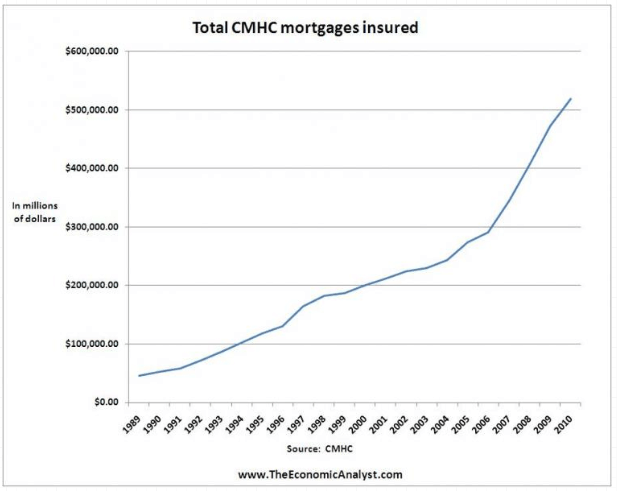
It’s also not hard to see from the above discussion that Canada’s mortgage system contains high levels of moral hazard. In a mortgage market free of government manipulation, a lending institution would carefully consider what interest rate to charge a person. They would take into consideration their credit worthiness, payment history, and down payment, since negative equity is one of the important determinants of default rates. However, with their default risk removed via the CMHC, Canada’s banks are more willing and able to lend to people with little money, a poor savings history and little prospect of repaying their loans. Put another way, CMHC enables the banks to provide the cheapest, lowest mortgage rates to those with the highest default risk.
Sound familiar? The CMHC is in effect similar to the United States government-sponsored Federal National Mortgage Association (Fannie Mae) and the Federal Home Mortgage Corporation (Freddie Mac), which provided insurance against default risk to a large proportion of risky low-deposit loans in the United States and whom required massive taxpayer bail-outs following the bursting of their housing bubble.
Canadian Taxpayers: on the Hook for Billions
A series of reforms over the past decade significantly increased CMHC’s exposure to mortgage default risk.
In 1999, the National Housing Act and the Canada Mortgage and Housing Corporation Act were modified, allowing for the introduction of a 5% down payment.
In 2003, CMHC removed the price ceilings limitations, thereby insuring any mortgage regardless of the cost of the home.
In 2007, CMHC allowed people to purchase a home with no down payment and ammortise it over 40 years. This was changed back to a 5% down payment requirement and a maximum amortisation of 35 years in late 2008, and then 5%/30 year maximum amortisation requirement in March 2011.
Finally, in an effort to support the housing market in 2008 (when affordability fell sharply and the economy slumped), the Canadian Government directed the CMHC to increase approvals of high-risk borrowers in order to keep credit flowing. As a result, the approval rate for these higher risk loans went from 33% in 2007 to 42% in 2008. By mid-2007, the average Canadian home buyer who took out a mortgage had only 6% equity in their home, suggesting the risk of negative equity is high even if there is only a moderate correction.
As you can gather from the above analysis, Canada’s mortgage underwriting standards are not exactly conservative. While the current CMHC rules now dictate that borrowers must provide a 5% down payment in order to obtain financing (reduced from 0% in 2007-08), many Canadian banks are side-stepping the CMHC rules by offering 5% to 7% cash-back offers, thus effectively providing 100% finance (click to see examples of the banks’ cash-back offers).
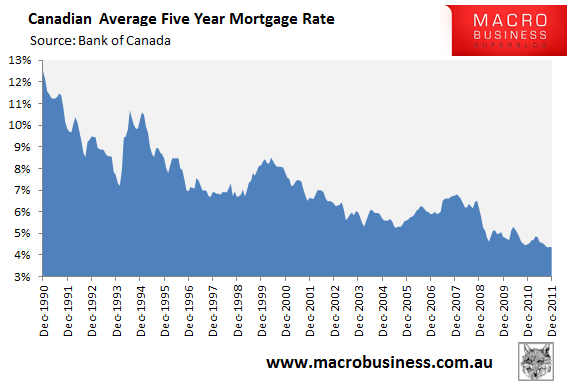
With mortgage rates in Canada near cyclical lows (see above chart), with nowhere to go but up, there is potential to generate significant mortgage stress and a wave of defaults amongst recent highly leveraged buyers, particularly the 30% of CMHC-insured borrowers with less than 20% equity in their homes (see below chart). There is also the risk that many recent buyers could find themselves in negative equity, whereby home values fall below borrowings, leading to a sharp drop in consumer spending, a reduction in economic growth, and job losses.
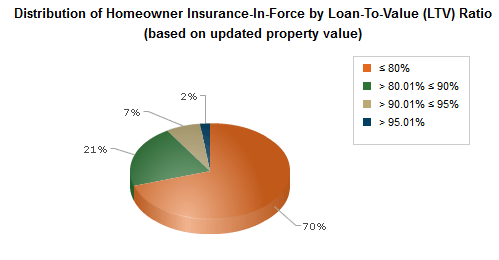
However, perhaps the most worrying aspect of Canada’s mortgage system is that the CMHC appears to be significantly under-capitalised, potentially exposing Canadian taxpayers to significant losses should Canada’s housing market enter a protracted down-turn. As at 30 September 2011, the CMHC had only $11.5 billion CAD of shareholder capital but a whopping $541 billion CAD of outstanding insured loans, which works out at only 2.1% equity against its overall exposure. In fact, the CMHC’s capitalisation is only slightly better than the US Government-sponsored Fannie Mae, which in 2007, at the peak of the US housing bubble, backed up US$2.7 trillion of mortgage-backed securities with US$40 billion of capital, or 1.5% equity against its overall exposure.
Should a severe housing correction occur, and significant defaults take place, there is very little capital available to absorb losses. Rather, like in the United States, Canadian taxpayers might be called upon to stump-up funds to bail-out the banks for their risky mortgage lending.
Canada’s mortgage monster:
Concerns about the CMHC prompted Canada’s leading weekly news magazine, Macleans.ca, in 2011 to publish a damning article entitled The CMHC: Canada’s mortgage monster, in which Macleans questioned the CMHC’s opaque disclosure practices, lack of regulatory oversight, and risk to taxpayers should a significant housing correction ever occur. The below quote from the Maclean’s article summarises the key issues:
It’s a familiar-sounding story to American ears. “The Canadian government mortgage apparatus echoes uncannily our experiences down here with Fannie and Freddie” says Jim Grant, author of the widely read Grant’s Interest Rate Observer newsletter. “CMHC has distorted the housing market by making homes, especially ones that are on the pricier end of the spectrum, more affordable and encouraged a lot of people to get in over their heads”…
What bothers Grant is that the CMHC’s government-backed guarantees encourage banks to feel they have less to lose if loans go bad. “The risk has been shifted, rather than reduced, from the stockholders and depositors of the big Canadian banks to the Canadian taxpayer,” he says. And if house prices fall and borrowers get into trouble, the ripples would run far and wide. “A sharp break in Canadian house prices would inflict terrific damage to consumer confidence, would hurt the Canadian labour market, and ultimately produce a lot of the unpleasant results that have been America’s burden to bear since 2007.”
Similar concerns were articulated by the Fraser Institute, which released a study in 2010 highlighting the risks to taxpayers from the CMHC-insurance system and explicitly recommended that Canada instead look to emulate the Australian privatised mortgage market structure. This study also confirmed that the taxpayer risk from a housing collapse is greater in Canada than elsewhere.
A ticking time bomb?
Only a year ago, the mainstream view in Canada was that the housing market was bullet-proof and that a US-style meltdown was highly improbable. Now sentiment appears to be changing following a slowing of sales, a build-up of inventory, and early signs of a price correction.
While it’s impossible to know what the future holds for the Canadian housing market, it appears that the risks are now on the downside. With any luck, Canadian house prices will deflate gradually, minimising damage to households, the economy and taxpayers alike. Perhaps such is possible given Canada, like Australia if less so, has seen a big shift in its terms of trade owing to the rise of China. But there is also a risk that prices will burst violently, as they did in the US, potentially exposing Canadian taxpayers to billions of dollars of losses.
As we explained on Wednesday, Mark Bouris and Christopher Joye from Yellow Brick Road Wealth Management have been campaigning hard for the Australian Government to ‘reform’ Australia’s banking system by implementing the CMHC (and Fannie Mae and Freddie Mac) system of guaranteeing pools of mortgages aggregated from all banks and non-bank lenders. Such a system is expected to end up costing US taxpayers between $120 billion and $190 billion, and from the above analysis, there are legitimate concerns that Canadian taxpayers could end up losing billions of dollar too from the CMHC.
Leith van Onselen writes as the Unconventional Economist. He is an economist that has previously worked at the Australian Treasury, Victorian Treasury and Goldman Sachs. Leith can also be found on twitter: twitter.com/leithvo. Find a selection of other posts below:
Australian Housing Valuation Report
How the RBA undervalued housing
How Germany achieved stable & affordable housing
Look to Texas to solve Australian housing supply
A full list of his posts is available here.

